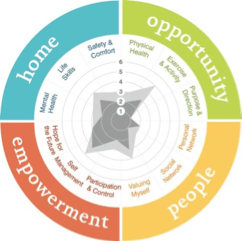Recommended validated measures for wellbeing
1. Warwick – Edinburgh Mental Wellbeing Scale (WEMWBS)
What is it?
The Warwick-Edinburgh Mental Wellbeing scale was developed to enable the monitoring of mental wellbeing in the general population (age 13-74) and the evaluation of projects, programmes and policies which aim to improve mental wellbeing.
WEMWBS has 2 scales: the original 14-item scale and an short 7-item scale. The scales are simple to complete and score. It comprises positively worded statements with five response categories from ‘none of the time’ to ‘all of the time.’
A meaningful change has been achieved if the score increases or decreased by between 3 and 8 points.
When is it used?
The scales have been validated for use in:
-
- A wide variety of different geographical locations, languages and cultural contexts
- Many different settings including the workplace, schools, health services and community wellbeing projects e.g. creative arts, gardening and walking group
Why use this scale?
WEBWMS:
-
- Is a validated measurement tool which is sensitive for changes in both mental health and wellbeing
- Works well for change in both individuals and groups and correlates well with other validated measures
- Is widely used in Scotland which facilitates benchmarking of performance with other services
- Is free to use with a simple registration process
- Recommended as a key measure by ‘What Works for Wellbeing'
Further reading
To register for access to the WEMWBS and for further information on its use please see:
NHS Coventry have produced an excellent practitioner guide to the use of this scale
The What Works for Wellbeing website has produced an excellent briefing on the WEMWBS scale and insights into its use. These can be accessed through the following links:
2. Work And Social Adjustment Scale (WSAS)
What is it?
- WSAS is a reliable and valid measure of a person’s functioning at home, at work or in social activities and relationships
- It is simple to complete with 5 questions, with a recommended frequency of every 4 weeks
- WSAS is scored between 0 and 40. The lower the number the better a person is functioning. It is recommended that the tool is used every 4 weeks
Why use this scale?
- It is simple to complete with only 5 questions
- It is a well recognised tool to demonstrate regular progress and inform care and support approaches.
It is worth noting that the scale refers to a person’s problem. It is not recommended to change wording in measures as this may affect their reliability and validity. However, if you feel you need to alter, the word ‘problem’ could be amended to challenges or difficulties.
Further reading
3. Individual Recovery Outcomes Counter (I.ROC)
What is it?
- The Individual Recovery Outcomes Counter (I.ROC) is a self-assessment questionnaire that measures recovery using the HOPE Model of wellbeing:
- Home - a safe and secure place to live
- Opportunity - to pursue meaningful leisure, recreation, education and work possibilities
- People - as friends, confidantes and supporters
- Empowerment - fully involved in decisions affecting own life
- Three questions are asked for each of the four categories building to a graphic illustration of the results as illustrated in the example below.
Click to enlarge
Why use this scale?
- I.ROC is used as a tool to show regular progress and inform care and support approaches. It is less commonly used to benchmark outcomes against other services or activities.
- The visual representation of scores can help clearly identify areas of progress or where further support is required.
Further reading
Previous
How to measure progress against common outcome measures for survivors
Next
Recommended validated measures for counselling
